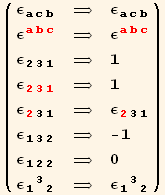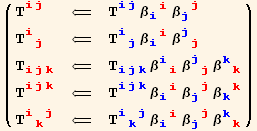3. The Cross Product
Initialization
![]()
![]()
![]()
![]()
![]()
![]()
![]()
![]()
![]()
![]()
The following values are taken as an example of a (red) basis frame :
![]()
![]()
![]()
![]()
![]()
![]()
Completely antisymmetric symbol


![]()
![]()
![]()
![]()
Remark : AntiSymmetric includes the factor 1/ n!
![]()
![]()
![]()
![]()
Definition of the operator CrossProductExpansion which calculate the ScalarTripleProduct of the basis set, and the Cross Product of two basis vectors.:
CrossProductExpansion[e_,e_][expr] expand the triple scalar products and the cross products expressed in a given basis e into LeviCivita symbols e. The considered space is three-dimensional.
In an orthonormal (blue-)basis, ![]() is simply a PermutationSymbol [e] and the cross product of two basis vectors is given by
is simply a PermutationSymbol [e] and the cross product of two basis vectors is given by
![]()
![]()
![]()

Determinants
The two kinds of PermutationSymbolRule[ε] εddd[i,j,k] or εuuu[i,j,k] also allow to calculate determinants (in the base system) :
![]()
![]()
![]()
![]()
![]()
![]()
![]()
![]()
![]()
![]()
![]()
and of course we can verify the equivalence of the above detA with the build in Det function :
![]()
![]()
![]()
![]()
Determinants of the metric tensors g

![( {{Det[g_ (ij)^(ij)], ⇒, 1/9}, {Det[g_ (ij)^(ij)], ⇒, 9}, {Det[g_ (ij)^(ij)], ⇒, 1}} )](HTMLFiles/index_48.gif)
Transformation tensors β
Example : Basis change from the black to the red basis (see Chapter 1)
![]()
![]()
![]()
![]()
![]()
![]()
![]()
Determinants of the transformation tensors β
Introduction of a determinant Δ of a transformation matrix β between the initial flavor, flavor1, to the final flavor, flavor2.
Note : I shall have to check the homogeneity of the notations between initial and final situations (see ToFlavor for instance, for which it is the reverse).
![]()
![]()
![]()
![]()
![]()
Introduction of the elementary volume formed by the basis set ![]() (for the red flavor) associated to g
(for the red flavor) associated to g
![]()
![]()
![]()
![]()
From the relation between the two basis ![]() =
= ![]()
![]()
![]()
![]()
![]()
![]()
Basis Change of any tensor
Examples :


We can now extend the antisymmetric tensor ε ddd [ i , j , k ] to general coordinate systems and define a tensor eddd [ i , j , k ] and equivalently a tensor euuu [ i , j , k ] . These tensors are called permutation tensors or Levi-Civita tensors.
Levi-Civita tensors
![]()
![]()
![]()
![]()
![]()
![]()
![]()
![]()
![]()
![]()
![]()
![]()
![]()

![]()
![]()
We also introduce here, to be complete, the standard notation used in the Standard Packages.
![]()
![]()
![]()
We can define for convenience :
![]()
![]()
![]()
![]()
![]()
![]()
![]()
![]()
![]()
![]()
![]()
![]()
![]()
![]()
![]()
![]()
![]()
![]()
![]()
The "black" basis is orthonormal. But not the red's one :
![]()
![]()
Consider the three following vectors :
![]()
![]()
![]()
![]()
![]()
![]()
![]()
![]()
![]()
![]()
![]()
ScalarTripleProduct is defined in the package Calculus`VectorAnalysis` . We define here the operation MetricTripleProduct which groups all the operation performed above
![]()
![]()
![]()
![]()
![]()
![]()
![]()
![]()
![]()
Definition of an element of surface and of volume
![]()
![]()
![]()
![]()
![]()
![]()
The volume element defined by the three vectors {dr, ds, dt} is :
![]()
![]()
![]()
Its explicit value is :
![]()
![]()
![]()
![]()
In another reference frame this volume will remain unchanged. So we must be very careful that only the LeviCivita (e here) symbol is a tensor.
So, the correct transformation is :
![]()
![]()
Definition of an area element by the vector dA normal to it :
![]()
![]()
![]()
![]()
![]()
Note the possibility to use both FullForm (Tensor[...]) and Shortcut form to write an identity,
the two forms below being not litterally identical :
![]()
![]()
![]()
![]()
Pressure p of a fluid or a gas
Its product with an area dA,on which it acts,is a force dF normal to the area,i.e.it has the direction of dA,with components:
![]()
![]()
![]()
Weight of a volume element dV
The weight dW of a volume element dV is a vector (direction of the gravity field), the product of the volume and the specific weight ϒ :
![]()
![]()
hence
![]()
![]()
dW also remains invariant by any change of frame. Explicitly we have,
![]()
![]()
![]()
| Created by Mathematica (November 27, 2007) |